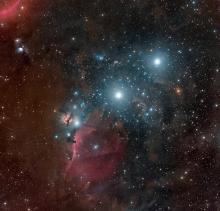Listen to today's episode of StarDate on the web the same day it airs in high-quality streaming audio without any extra ads or announcements. Choose a $8 one-month pass, or listen every day for a year for just $30.
You are here
Alnilam
If you could catch the hot gas that the star Alnilam is blowing into space, in a million years you’d have enough to make two stars as heavy as the Sun. But you wouldn’t be able to tell much difference in Alnilam itself, because it’s one of the monsters of the Milky Way.
Alnilam is the “buckle” in Orion’s Belt, a compact line of three bright stars. It rolls across the south on winter nights.
It’s the most impressive member of the belt. As seen from Earth, it’s the brightest of the three stars, even though it’s hundreds of light-years farther away. And while each of the others consists of more than one star, Alnilam moves through the galaxy alone.
Alnilam is a supergiant. It’s more than 60 times as massive as the Sun, tens of thousands of degrees hotter, and hundreds of thousands of times brighter. Its radiation is so intense, that it blows a dense “wind” of hot gas from its surface. The wind races into space at millions of miles an hour.
Although Alnilam is only a few million years old, it’s nearing the end of its life. It’s probably consumed its original hydrogen fuel. Over the next few million years, it’ll burn through a series of heavier elements forged in its core.
Eventually, though, it won’t be able to sustain that process any longer. Its core will collapse, while its outer layers blast into space as a supernova — briefly outshining the combined light of most of the other stars in the galaxy.
Script by Damond Benningfield






